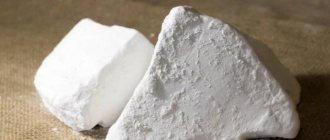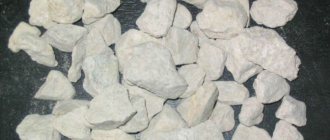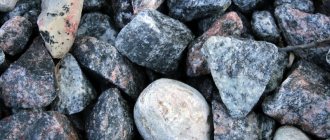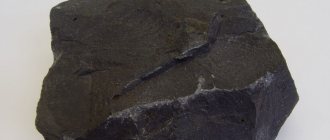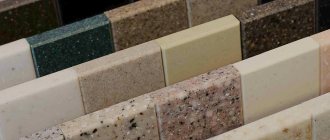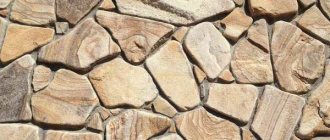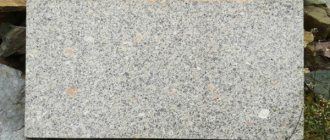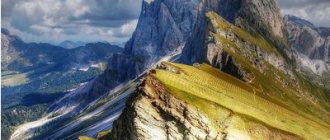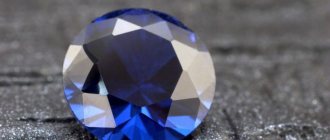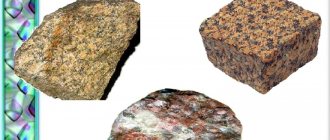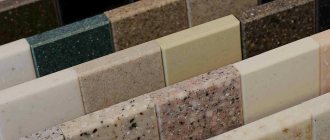What characteristics do granite and basalt have, and how do they differ from each other? Firstly, these breeds have different origins, and secondly, each of them has its own structure, which immediately catches the eye. Thirdly, both granite and basalt are strong, but basalt is still stronger. However, this does not mean that granite processing is much easier. So, first things first.
Granite
Granite is a deep-seated, holocrystalline rock consisting mainly of feldspar, mica and quartz.
The quartz content in granites is up to 30%. The number of colors of granite: there are several basic tones, namely: red, brown and greenish, as well as light gray-black tones. The strength of granite depends on the size of the grains. Granites with a fine-grained and medium-grained structure are distinguished by high strength (compressive strength up to 3000 kg/cm2, bulk density 2740 kg/m3). Granites with a fine-grained structure are most suitable for sculptural purposes; they can be processed without undirected chipping; the surface is well polished and retains polish for a long time. Fine-grained granites are characterized by uniform color without texture or have a texture formed from colored layers.
Place of Birth
Granite quarries are located on almost all continents of the planet; their largest concentration is off the coast of North America, in the Russian Federation and Ukraine. The most famous places where granite is mined in Russia are Karelia, Leningrad region, and the Urals.
The basins of the Yenisei and Lena rivers flowing on the territory of the Russian Federation and the territory of Eastern Siberia are rich in basalt. Deposits of this rock are also found in Armenia, Ukraine, Ethiopia, India, Brazil, and North America. And also off the coasts of island countries such as Australia, Greenland and Iceland.
Diorite
Diorite is a plutonic rock consisting primarily of the mineral plagioclase, including the colored mineral hornblende.
Sometimes quartz is present, in which case the rock is called quartz diorite. The color of diorite is gray, dark gray, grayish green. The color of diorite is lighter than that of gabbro, sometimes they have a completely leucocratic appearance.
The structure of diorite is medium-grained (less often fine-grained), the polishability of diorite is average. Compressive strength 1800-2400 kg/cm2, volumetric mass 2640 kg/m3.
Mid-ocean ridges
Mid-ocean ridges are a type of boundary between two tectonic plates consisting of oceanic crust. It is in the middle of ocean ridges that new oceanic crust is formed. The upper 1-2 km of the oceanic crust is basaltic. The basalt that forms in the middle of ocean ridges has a special composition that makes it distinctive, as a result, the basalt deposits that form in the middle of ocean ridges are called MORB (mid-ocean ridge basalt) or MORB.
Labradorite
Labradorite is a deep-seated coarse-crystalline rock consisting of plagioclase with an admixture of dark minerals contained in the rock from 2 to 25% (pyroxene, olivine and titanic iron ore - ilmenite).
There are two types of labradorite - almost black in the form of lacy black crystals with a dark blue, golden, and sometimes reddish tint. The second variety of labradorite is light gray with large plagioclase crystals; its color is distinguished by a delicate play of blue tones. Color dark gray, greenish gray, bluish gray.
A characteristic feature of labradorite is irradiation (shimmer) - the formation of reflections on the polished surface of feldspar grains caused by inclusions of the mineral ilmenite. The colors of the shimmering crystals are blue, light blue and gold, the crystal sizes are 10-15 cm.
Labradorite is easier to process than granite due to its viscosity. Labradorites with a grain size of 6-7 mm are better processed. Compressive strength from 1000 to 2000 kg/cm2, volumetric mass 2340 kg/m3.
Terminological dictionary
RUBBLE STONE - pieces of rock (limestone, dolomite, sandstone, less often granite) measuring 150-500 mm, weighing 20-40 kg, irregular in shape, with standardized strength and frost resistance. It is used for laying foundations, underground walls and walls of unheated rooms, retaining walls, ice cutters, settling tanks and tanks.
BLOCKS – angular fragments of rock more than 1000 mm in size. Used in landscaping and wall laying.
LASCHADKA or OKOL - rock fragments obtained during processing and having a flat, uneven surface. Length 100-250 mm, thickness 30-80 mm. Used in landscape work.
STRUCTURE is a characteristic of the shape, size and degree of isolation of the particles that make up the rock. The structure can be amorphous, crystalline, granular, and so on.
TEXTURE - the nature of the composition of rock particles in its volume (homogeneous, layered, banded, etc.). Texture determines what kind of pattern can be obtained on a cut stone.
TEXTURE – surface relief. The textures of the front surfaces are divided according to processing methods into abrasive (polished, ground, sawn) and impact (“fur coat”, “rock”, point).
Abrasive treatment contributes to the durability of the stone. Polishing is most effective in this regard, since water and aggressive substances do not linger on a completely smooth surface.
NATURAL WEAR - the thickness of the layer erased from a stone slab by a human flow of 1 million people per year.
STONE HARDNESS - the ability to resist the penetration of other, harder bodies, as well as the general ability to draw and cut with various objects. There are many ways to determine hardness, the most famous was proposed by the German scientist Friedrich Mohs. On the Mohs scale, 1 is the hardness of talc, and 10 is the hardness of diamond. The hardness of granite is 6-7, marble – 2-5, limestone – 1-5.
Gabbro
Gabbro is a deep-seated, holocrystalline, dense, viscous rock consisting of plagioclase and the dark minerals hornblende and biotite. The presence of these minerals gives gabbro its color - mainly gray to black.
Gabbro rocks are among the best sculptural materials for monument pedestals and are easy to process.
The texture of the surface processed with percussion instruments has a light gray color, so inscriptions and ornaments stand out in particular contrast.
Compressive strength up to 2000 kg/cm2, volumetric mass 2970 kg/m3.
Differences between basalt and granite
While there are some similarities between basalt and granite, there are also significant differences between the two rock types.
- Basaltic is volcanic or extrusive, forming on the surface, while granite is plutonic or intrusive, forming below the surface.
- Basalt is mafic while granite is felsic
- Basalt is common on Earth and other solar system bodies such as the Moon and Mars while granite is common only on Earth and rare elsewhere in the solar system
- Basalt can form within days to months, while granite plutons can take millions of years to cool and harden.
- Basalt is more common in oceanic crust while granite is more common in continental crust.
Basalt Vs. granite
Luxurious stone tombstone - the last tribute to the deceased
The phrase “eternal memory” can be embodied in the material. And this material will be natural stone. A tombstone of this design will become an aesthetic and long-lasting reminder of the departed. Various forms of production will help to capture the lifestyle and reflect the character traits of a loved one.
The unique properties of stone products are reflected in:
- reliability
- resistance to external influences
- availability of material
- variety of colors and textures
Types of stone by origin
The most important criterion for classifying rocks is the type of origin. There are three main methods of stone origin:
- magmatic – primary, or endogenous;
- sedimentary – secondary, or exogenous;
- metamorphic - transformation of igneous or sedimentary rocks under the influence of external factors.
Igneous origin
Rocks of igneous, or endogenous origin, are formed as a result of the solidification of lava. The final structure of the stone depends on its composition, cooling rate and atmospheric factors. There are two types of magmatites:
- Intrusive. Magma gradually solidifies deep underground, putting enormous pressure on the rock. As a result, dense and massive crystallized blocks are formed, practically free of pores and voids.
- Effusive. Lava solidifies on the surface or in the upper layers of the earth through a volcanic eruption, and solidification occurs at low temperatures and occurs unevenly. Such rocks are more fragile and porous, and they often contain cracks.
During the eruption process, hot magma passes through other compounds and dissolves them into itself. According to their chemical composition, igneous rocks are usually divided into:
- acidic - silicon dioxide content more than 65%, with impurities of potassium and sodium;
- medium – 54-65% silicon dioxide, in the presence of aluminum and calcium;
- the main ones are silicon dioxide in the range of 45-54%;
- ultrabasic - less than 45% with a significant content of iron and magnesium.
Sedimentary origin of rocks
A stone of sedimentary or exogenous origin is formed during the destruction of rocks by external factors - atmospheric phenomena, temperature changes. They are found everywhere on the surface of the earth, spreading by currents of air and water. They often accumulate at the bottom of reservoirs, then settle and become compacted. There are the following subspecies:
- clastic – formed from parts of igneous origin;
- biochemical - formed due to the mixing of organic and inorganic compounds;
- chemogenic - consist of deposited sediments of concentrated solutions;
- biogenic - are the ossified remains and waste products of animal and plant origin.
Biogenic and biochemical sedimentary rocks form combustible substances such as coal, shale, peat, and oil.
Metamorphic rock formation
Metamorphic rocks are formed by transformation from other types of rocks. This occurs due to exposure to high temperature, pressure, and chemically active substances. The minerals that made up the primary rock are broken down by factors and then assembled into other compounds that form metamorphic rock. For example, clay, under the influence of metamorphism, turns into shale, and quartz sandstone into quartzite.
Depending on how intense the metamorphic transformation process was, it is not always possible to accurately determine which rock was the primary one. According to the conditions of formation of such rocks, the following types are distinguished:
- Regional. They are formed when lithospheric plates shift, when one mineral rock penetrates deep into another. Accompanied by strong pressure and high temperature.
- Hydrothermal. Occur with the direct participation of underground hot springs. Due to strong heating, the components that make up the rock enter into a chemical reaction and are converted into other compounds.
- Contact. They are formed near intrusive-type magmatites under the influence of high temperature on individual layers of the earth's crust. A distinctive feature of this type of metamorphism is the formation of large mineral crystals of high strength.
Meteorites - space rocks
About two thousand tons of cosmic rock fall to Earth every year. In most cases it consists of silicates such as olifin, fayalite, forsterite, pyroxene, ferrosilite and enstatite. Meteorite formations are predominantly chondriacal in appearance, and their composition is similar to that of the Sun, with the exception of hydrogen and helium. It is likely that rock-type meteorites are formed from the protoplanetary cloud surrounding the Sun through the gravitational attraction of dust and condensation of substances. Used in jewelry and decorative purposes.
Where is Syenite used?
They are used in construction as crushed stone (in buildings and structures with low requirements for durability and strength), as well as for the production of glass and ceramics (as feldspar substitutes). The most important area of application of nepheline syenites is the production of alumina for the aluminum industry.
Interesting materials:
How to return to old WhatsApp? How to politely respond to an invitation? How does an echo sounder see fish? How does vinpocetine affect blood pressure? How does adrenaline affect the bronchi? How does adrenaline affect the coronary vessels? How does a capacitor affect processes in an alternating current circuit? How does unemployment benefit affect your pension? How to assign additional responsibilities to an employee? How to enter additional OKVED for individual entrepreneurs?
Hotspots
Hot spots are areas near the base of the crust where a plume of hot mantle material causes volcanic activity at the surface. When hot spots occur beneath oceanic crust, the resulting molten rock often produces basaltic lavas. Examples of basaltic deposits that form in hot spots include the basaltic bedrock of the Hawaiian Islands. The Martian volcanoes Tharsis, Olympus Mons, Ascraeus Mons, and Arsia Mons are likely examples of hot spot volcanism on a much larger scale than those found on Earth.
